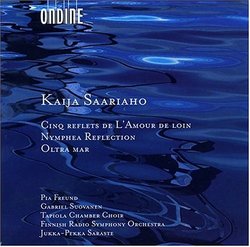| All Artists: Kaija Saariaho, Pia Freund, Gabriel Suovenen, Jukka-Pekka Saraste, Finnish Radio Symphony Orchestra Title: Kaija Saariaho: Cinq Reflets de L'Amour de Loin; Nymphea Reflection; Oltra Mar Members Wishing: 2 Total Copies: 0 Label: Ondine Release Date: 1/25/2005 Genres: Pop, Classical Styles: Vocal Pop, Opera & Classical Vocal, Historical Periods, Modern, 20th, & 21st Century Number of Discs: 1 SwapaCD Credits: 1 UPC: 761195104927 |
Search - Kaija Saariaho, Pia Freund, Gabriel Suovenen :: Kaija Saariaho: Cinq Reflets de L'Amour de Loin; Nymphea Reflection; Oltra Mar
 | Kaija Saariaho, Pia Freund, Gabriel Suovenen Kaija Saariaho: Cinq Reflets de L'Amour de Loin; Nymphea Reflection; Oltra Mar Genres: Pop, Classical
|
Larger Image |
CD Details |
CD ReviewsNot really sure what's going on with Saariaho Christopher Culver | 10/27/2005 (3 out of 5 stars) "This Ondine disc collects three relatively recent works by Finnish composer Kaija Saariaho, performed by the Finnish Radio Symphony Orchestra and Jukka-Pekka Saraste with other talented musicians. Saariaho's earlier work was characterized by a focus on timbre and the use of electronics, but she seems to have moved on to an interest in melody and eschews electronics. "Cinq reflets" for soprano, baritone, and orchestra is an arrangement of five scenes from her 2000 opera "L'amour de loin", concerning the consuming love of the 12th century troubadour for the countess of Tripoli, whom he never met. Here Pia Freud performs the part of the countess and Gabriel Suovanen the part of Rudel. This doesn't stack up to Saariaho's earlier work, but is entertaining enough listening. "Nymphea Reflection" for string orchestra (2001) is a reworking of her "Nymphea" for string quartet and electronics. Originally Saariaho intended to merely replace the electronics with additional strings, but found that they were not capable of the same subtleties, hence the extensive rewriting. The result is certainly less thrilling than the quartet, but still very interesting in its textures. Certainly the best of the pieces here. "Oltra mar" (1998-1999) is a set of seven preludes for the new millenium for orchestra and choir, which last part is here the Tapiola Chamber Choir. Going from "Depart" to "Arrivee" (in that order), only three of these preludes have texts, by an Arab poet and African pygmies, while the rest have mere vocalizations. The sixth, "Mort" is in memory of Gerard Grisey, the spectralist composer who influenced Saariaho significantly. Some of the material here later found its way into the opera; the first movement is used for the pilgrim's journey at the beginning of the fourth act. I must admit, I don't enjoy "Oltra mar" at all. It is almost reminiscent of the vacuity of ideas found in the works of the "holy minimalists" like most of 1980s Arvo Part. Saariaho's earlier work is simply stunning. The beauty of pieces like "Amers" and "Du cristal ...a la fumee" defies description, and part of their success is the focus on timbre and the possibilities electronics bring. Now that Saariaho is writing melodies and electronics are nowhere to be found, I feel that her work has lessened. The first two pieces here are still entertaining, but it doesn't match what came before." Three dramatic works -- operatic, orchestral and choral R. Hutchinson | a world ruled by fossil fuels and fossil minds | 06/11/2005 (4 out of 5 stars) "One might think that with her growing reputation as one of the best contemporary composers, Kaija Saariaho would be recording for larger labels than Finland's own Ondine. As it turns out, that is exactly right -- the complete opera L'AMOUR DE LOIN, which premiered in Salzburg in 2000, and which won the Grawemeyer Composition Award in 2003, is scheduled for DVD release on Deutsche Grammophon later this year. In the meantime, the most excellent Ondine label has brought us these "Five Reflections on Love From Afar" (2001 -- 29'28), taken from the opera, featuring the soprano voice of Pia Freund and Gabriel Suovanen's baritone. The setting is the 12th century, and the characters include a troubador, a countess, and a wandering pilgrim. The sentiments are lofty and remote, as well they might be given that they are after all "from afar." Award notwithstanding, it strikes me as stolid and static. Once again, I'm forced to wonder if there is anything but disappointment in merely listening to music (opera) which is designed with a dramatic, visual component.
I am much more impressed by the other two new works by Saariaho. "Nymphea Reflection" (2001 -- 21'40) is a new version of the piece originally written for string quartet and electronics -- see my reviews of both recordings, by the Kronos Quartet on Ondine (DU CRISTAL ... A LA FUMEE) and the Arditti Quartet on Naive/Montaigne (FROM SCANDINAVIA). Utilizing the orchestra (the Finnish Radio Symphony Orchestra, Jukka-Pekka Saraste conducting), Saariaho creates Xenakis-like glissandos, and other sounds that were previously created with electronics, sequences based on spectral analysis and Ligeti-like microintervals. The piece has six sections, each with a distinct texture, all inspired by Monet's painting of water lilies and the metamorphoses created by rippling water. The final of the three new works, "Oltra Mar" (1998/9 -- 21'53), features the Tapiola Chamber Choir and the FRSO. The work has seven movements, "encompassing the whole of human existence between departure and arrival." No, I didn't reverse the two -- in this metaphysical work, we depart from and arrive back in heaven/the infinite, with our terrrestrial life in between. "Oltra Mar" was dedicated to Gerard Grisey, the composer associated with the technique of spectralism, one of Saariaho's most important teachers. This is a powerful work, and it closes with the following lines, identified as a funeral lament of the Pygmies: "The sky has cleared, the eyes have dimmed, the star shines. The person has gone, the shadow has vanished, the prisoner is free." " |

 Track Listings (18) - Disc #1
Track Listings (18) - Disc #1